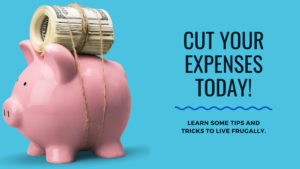
Your Ultimate Guide to Financial Order of Operations
Unlock the secrets to financial success through strategic planning.
Navigate the complexities of money management with actionable steps.
Gain insights from real-life experiences and expert advice.
Understanding Financial Order of Operations
In the vast sea of financial advice, finding a guiding light can be challenging. That’s where the Financial Order of Operations (FOOO) comes in a meticulously crafted framework that serves as a roadmap to mastering your finances. As I share my journey from Mexico, I invite you to join me on this exploration of financial wisdom.
The Strategic Significance
FOOO isn’t just another set of rules, it’s a strategic approach to managing money that considers the intricacies of your financial landscape. It’s about more than just budgeting or investing, it’s a holistic plan designed to lead you toward financial freedom.
Importance of Budgeting
Budgeting a word that often brings sighs and eye rolls. But let’s strip away the stress and consider it a powerful tool on your journey to financial mastery.
Role of Budgeting
Picture your budget as the GPS of your financial life. It’s not about limiting yourself, it’s about understanding where your finances are allocated. A budget helps you understand your income, track your expenses and ensures that every dollar has a purpose. It’s your financial roadmap, guiding you toward your goals.
In practical terms, budgeting allows you to allocate your money deliberately. You get to decide where your hard-earned cash goes, whether it’s to bills, savings, or that occasional treat. It’s the foundation of financial control, providing a clear picture of your financial health.
Practical Tips
Creating a budget doesn’t mean becoming a spreadsheet wizard overnight. Start simple. List your income sources and track your regular monthly expenses. Use apps or pen and paper whatever feels comfortable.
Know Your Income: Understand your take-home pay after taxes.
Track Expenses: Categorize your spending, from rent to that morning coffee.
Set Goals: Allocate money for savings, emergencies and personal goals.
Review Regularly: Adapt your budget as life changes.
Remember, a budget is not about perfection, it’s about progress. It’s your tool, shaped by your lifestyle and aspirations.
Mastering Cash Flow
Picture your finances as a river of money flowing in and out, carving the path to your financial landscape. Mastering this cash flow isn’t about doing fancy financial acrobatics, it’s about optimizing the currents to navigate smoothly.
Optimizing Inflows and Outflows
Let’s talk first about the money coming in. Whether it’s your salary, side hustle earnings, or passive income, understanding and maximizing these streams are crucial. Think of it as widening the riverbanks, allowing more financial abundance to flow in.
Now, let’s focus on the outflows of the expenses. We all have bills, groceries and that occasional treat-yourself moment. Mastering cash flow means strategically managing these outflows, ensuring they align with your financial goals. It’s not about deprivation, it’s about directing your money consciously.
Personal Cash Flow Management
Personal cash flow management is like being the captain of your financial ship. It involves understanding when to open the sails and catch the wind (increase spending) and when to navigate carefully through calm waters (cut back on non-essential expenses).
My own journey involved getting to know my cash flow intimately. I tracked my income, identified regular expenses and, most importantly, recognized my financial goals. This awareness allowed me to make informed decisions, optimizing my cash flow to work for my aspirations.

Prioritizing Expenses
When it comes to managing your money, understanding where it goes is the first step to financial mastery. Let’s break down two crucial aspects: categorizing expenses and the power of conscious spending.
Strategies for Categorizing
Think of your expenses as guests at a party, some are essential VIPs, others are nice-to-haves and a few might not even be on the guest list. Categorizing your expenses helps you identify who’s who. Start by distinguishing between necessities like rent, utilities and groceries and non-essentials like dining out or streaming subscriptions.
Create categories that make sense for your lifestyle. This could be as simple as “Essentials” and “Extras” or more detailed, like “Housing,” “Transportation,” and “Entertainment.” By organizing your spending into clear categories, you gain a bird’s eye view of where your money is flowing.
The Role of Conscious Spending
Ever found yourself mindlessly scrolling through online stores, only to realize later you’ve made an impulse purchase? Welcome to the realm of unconscious spending. Conscious spending is the antidote.
Being mindful of your financial goals and values helps you make intentional spending choices. Before making a purchase, ask yourself: Does this align with my priorities? Is my purchase driven by essential need or spontaneous impulse? Conscious spending isn’t about deprivation, it’s about allocating your resources where they matter most to you.

Managing High-Interest Debt
High-interest debt can feel like a heavy anchor, dragging down your financial ship. Let’s tackle this challenge head-on by addressing its impact and exploring efficient debt management strategies.
Addressing Impact
High-interest debt, often from credit cards or certain loans, is a financial hurdle that can hinder your progress. The hefty interest rates mean you’re not just paying back what you borrowed, you’re also handing over a significant chunk in interest. This can impede your ability to save, invest and achieve your financial goals.
Recognizing the impact is the first step. It’s like diagnosing an ailment before finding the cure. We’ll delve into efficient strategies to lighten this burden and pave the way for a more financially liberated future.
Efficient Debt Management
Tackling high-interest debt requires a strategic game plan. We’ll explore methods like the avalanche and snowball approaches, each with its unique strengths. Whether you prefer focusing on the highest interest rate debts first or gaining momentum by paying off small debts, there’s a strategy tailored to your financial personality.
Efficient debt management isn’t just about paying what you owe, it’s about doing so strategically, minimizing interest payments and accelerating your journey to debt-free living.
Building an Emergency Fund
Importance and Size
Now, let’s talk about the financial safety net. Everyone should have your emergency fund. Picture it as your financial superhero, ready to rescue you when unexpected expenses come knocking. The importance of this fund cannot be overstated. It’s not a matter of ‘if’ but ‘when’ life throws a curveball, be it a sudden medical expense or a car breakdown. Your emergency fund is the cushion that keeps you afloat.
So, how big should this superhero fund be? There’s no one-size-fits-all answer but a good rule of thumb is three to six months’ worth of living expenses. This ensures that you’re prepared for the unexpected without disrupting your financial stability.
Ideal Fund Placement
Now that we’ve established the ‘why’ and ‘how much,’ let’s discuss the ‘where.’ Your emergency fund needs to be easily accessible when you need it. Consider stashing it in a separate savings account. It’s not about chasing high interest but having quick, hassle-free access when you’re in a pinch.
Maximizing Employer Match Contributions
Leveraging Employer Match Programs
If your employer offers a match on your contributions to retirement accounts, consider it a golden ticket. This is a unique opportunity to boost your savings without any extra effort on your part. Imagine it as your employer saying, “Hey, we’ll contribute too!” It’s essentially free money.
The mechanics are simple. If your employer offers a match, contribute enough to take full advantage of it. If they match, for example, 50% of your contribution up to a certain percentage of your salary, contribute at least that percentage. It’s an instant return on investment and a powerful tool for building your financial future.
Real-World Examples
Let’s make this tangible with real-world examples. Take Sarah, who contributes 5% of her salary to her retirement account. Her employer matches 100% of the first 3%. By contributing that 5%, Sarah not only saves for her future but also gets an additional 3% from her employer. That’s a 60% return on her contribution.
By sharing these examples, we’re demystifying the world of employer match programs and empowering you to make the most of this valuable benefit.
Investing in a Roth and HSA- Maximizing Your Financial Potential
Ensuring a secure financial future requires prudent investment choices. Two powerful tools in your arsenal are Roth Individual Retirement Accounts (IRAs) and Health Savings Accounts (HSAs). Let’s uncover the benefits and practical contribution tips that can propel your financial journey.
Benefits of Roth IRAs and HSAs
Roth IRAs and HSAs are like hidden treasures in the world of personal finance. A Roth IRA offers tax-free withdrawals in retirement, allowing your investments to grow without being bogged down by taxes. On the other hand, an HSA combines health savings with investment opportunities, providing a triple tax advantage, contributions are tax-deductible, the growth is tax-free and withdrawals for qualified medical expenses are also tax-free. Imagine your money working for you in more ways than one.
Practical Contribution Tips
Now, let’s talk about strategy. Contributing to a Roth IRA and HSA is not just about putting money aside, it’s about optimizing your contributions for maximum impact. Consider contributing consistently, taking advantage of employer match programs if available and strategically allocating your investments within these accounts. Accumulating modest, regular contributions over time has the potential to result in noteworthy financial advancement.
Understanding Roth IRA- A Deeper Dive into Financial Freedom
Delving into the world of Roth IRAs opens up a realm of possibilities for financial growth. Let’s go beyond the surface and explore the in-depth insights and personal advantages that come with this investment vehicle.
In-depth Insights and Advantages
At its core, a Roth IRA is more than an account, it’s a tool for financial empowerment. With the ability to withdraw contributions tax-free at any time and earnings tax-free in retirement, it provides flexibility and freedom. Unlike traditional IRAs, there are no required minimum distributions, allowing you to maintain control over your financial destiny. We’ll unravel the advantages and how these align with your long-term goals.
Maximizing HSA Contributions
Role in Financial Planning
Health Savings Accounts (HSAs) are more than just a place to stash away money for medical expenses. Think of them as your secret weapon in the financial planning arsenal. An HSA is like a superhero cape for your budget, offering tax advantages that can significantly impact your overall financial health.
Contribution Strategies
Now, let’s talk about strategy. Maximizing your HSA contributions isn’t just about putting money aside for medical emergencies, it’s about leveraging a powerful tool for future financial stability. We’ll dive into smart contribution strategies that not only protect you from unexpected medical bills but also build a financial cushion for the long run.
Planning for Retirement
Importance of Retirement Planning
Picture this: sandy beaches, leisurely mornings and the freedom to do what you love without worrying about finances. That’s the dream, right? Retirement planning is the key to turning that dream into reality. In this section, we’ll unravel the importance of thinking ahead and making strategic moves today for a worry-free tomorrow.
Understanding Investment Vehicles
Embarking on your financial journey requires a keen understanding of various investment vehicles. These aren’t just avenues to park your money, they are the engines that drive your wealth-building journey.
Exploration of Options
Think of investment vehicles as the different routes you can take to reach your financial goals. From traditional options like mutual funds and bonds to more modern choices like ETFs and real estate, each avenue has its unique features and potential benefits. We’ll take a stroll through these options, shedding light on what makes each one tick.
Risk and Reward Considerations
Navigating the world of investments is akin to steering a ship through unpredictable waters. We’ll delve into the risk and reward dynamics of various investment vehicles. Understanding this balance is crucial, the windfall gains come hand in hand with potential pitfalls. This section will equip you with the knowledge to make informed decisions based on your risk tolerance and financial goals.

Investing in the Stock Market
The stock market is an enigma for some, a thrilling adventure for others. Investing in stocks can be a powerful way to grow your wealth but it comes with its own set of rules and nuances.
Strategies for Stock Market Investments
Venturing into the stock market requires a strategic approach. We’ll explore tried-and-true strategies that have stood the test of time. From value investing to growth stocks, we’ll dissect these approaches in plain language, ensuring you not only grasp the concepts but feel confident in applying them to your own investment portfolio.
Exploring Other Investment Options
When it comes to building wealth, diversification is more than just a buzzword, it’s a fundamental principle. Diversifying your investments means not putting all your financial eggs in one basket. Picture it like a chef crafting a well-balanced recipe – you want a mix of ingredients to create the perfect financial dish.
Why Diversify?
Diversification spreads your risk. Instead of relying heavily on one investment, you invest in a variety of assets. This can include stocks, bonds, real estate, or even alternative investments like precious metals. It’s like having a diversified stock of tools in your financial toolbox.
Real-World Alternatives
While stocks and bonds are the traditional go-tos, consider thinking outside the box. Real estate can be an excellent diversification strategy, offering both stability and potential for appreciation. Explore peer-to-peer lending platforms or consider investing in a small business. The key is finding what aligns with your risk tolerance and financial goals.
Managing Low-Interest Debt
Not all debt is created equal and managing low-interest debt is a delicate balancing act. While it might not have the urgency of high-interest debt, it’s crucial to address it strategically, especially when considering your long-term financial goals.
Addressing Low-Interest Debt
Low-interest debt, like student loans or a mortgage, often comes with more forgiving interest rates. Nevertheless, refrain from succumbing to a false sense of security. Even though the interest is lower, it’s still money that could be working for you elsewhere. Create a plan to consistently chip away at these debts while maximizing opportunities for growth elsewhere.
Balancing with Long-Term Goals
Consider your long-term goals when managing low-interest debt. Are you actively setting aside funds for a down payment on a house? Planning for your children’s education? Every dollar you allocate to debt repayment is a dollar that might not be contributing to these goals. Striking the right balance is key – paying down debt while still progressing toward your larger financial aspirations.
Achieving Financial Abundance
Transitioning Mindset
Now that we’ve navigated through the practical steps of financial planning, it’s time to delve into a crucial aspect of the often overlooked mindset. Achieving financial abundance isn’t just about numbers on a spreadsheet, it’s a mental shift toward recognizing opportunities, embracing abundance and letting go of scarcity thinking.
In my journey, this transition became a game-changer. I learned that financial abundance begins with a positive outlook. It’s about seeing possibilities rather than limitations, understanding that wealth goes beyond monetary value and appreciating the abundance in our lives.
Practical Steps
But how do you practically achieve this shift? Start by celebrating small wins. Acknowledge your progress, whether it’s paying off a debt or consistently saving. Embrace gratitude by recognizing the non-monetary aspects of your life that contribute to your overall wealth.
Consider giving back. It doesn’t have to be a grand gesture, even small acts of kindness create a positive cycle. Invest in experiences that bring joy and fulfillment, understanding that wealth is about the quality of life, not just the quantity of money.
Continuing Education and Resources
Role of Ongoing Financial Education
Financial literacy is a journey, not a destination. In this rapidly evolving financial landscape, continuous learning is the key to staying empowered and making informed decisions. Ongoing financial education is the compass that guides you through market shifts, policy changes and new investment opportunities.
From personal experience, I’ve found that dedicating time to learning about the latest trends, investment strategies and financial tools has significantly enhanced my ability to navigate the complexities of the financial world. It’s not about becoming an expert overnight but about consistently expanding your knowledge base.
Empowering Resources
But where do you find these empowering resources? Online courses and video lessons have emerged as invaluable tools, offering in-depth insights into various financial topics. Platforms like [Insert Platforms] provide accessible and practical courses that cater to different levels of expertise.
Additionally, joining a private Facebook group can create a sense of community and shared knowledge. Engaging with like-minded individuals allows you to learn from their experiences, gain diverse perspectives and stay updated on industry trends.
Online Courses and Video Lessons
Navigating the vast world of online financial education can be overwhelming. Here are some recommendations and personal favorites to guide you on your learning journey.
Recommendations
Khan Academy: Offers free, comprehensive courses on various financial topics, making complex concepts easily digestible.
Investopedia Academy: Their clear and concise lessons break down financial concepts, making them accessible for beginners.
Personal Favorites
Udemy: An array of courses, often budget-friendly or on sale, covering everything from budgeting to advanced investment strategies.
YouTube Channels: Channels like Graham Stephan or The Financial Diet provide valuable insights in an engaging format.
Joining a Private Facebook Group
Engaging with a community can be a game-changer in your financial journey. Consider the benefits of joining a private Facebook group.
Benefits of Community Engagement
Shared Experiences: Connect with others facing similar financial challenges, providing a sense of camaraderie.
Real-Time Advice: Get instant feedback and advice from a diverse group of individuals with different perspectives.
Tips for Finding Groups
Search Purposefully: Look for groups aligned with your specific financial goals, whether it’s debt reduction, investing, or general financial wellness.
Active Participation: Choose groups where members actively engage and share valuable insights rather than passive communities.
By actively participating in such communities, you not only expand your knowledge but also build a support system that can help you stay on track with your financial goals.
Conclusion
In the labyrinth of financial management, the Financial Order of Operations illuminates a clear path. As we wrap up this guide, let’s revisit the key insights that can revolutionize the way you approach your finances.
Summarizing Key Insights
Remember, it all starts with understanding your financial landscape. Budgeting isn’t restrictive, it’s empowering. Prioritize your expenses thoughtfully, address high-interest debt strategically and build a robust emergency fund. Maximize employer match contributions, dive into Roth IRAs and HSAs and plan for retirement with confidence. Embrace the world of investments, manage low-interest debt wisely and cultivate an abundance mindset.
Encouragement for Action
Now armed with these insights, take action. The Financial Order of Operations isn’t a passive guide, it’s a call to financial empowerment. Start today, evaluate your budget, reassess your debt and explore investment opportunities. Your journey to financial success begins with a single step and each step forward is a triumph.
The nine steps encompass understanding your financial landscape, mastering budgeting, optimizing cash flow, prioritizing expenses, managing high-interest debt, building an emergency fund, maximizing employer match contributions, investing in Roth and HSA accounts and planning for retirement.
Step 7 involves maximizing contributions to your Health Savings Account (HSA), a crucial aspect of strategic financial planning.
Hyper-accumulation refers to an advanced stage of wealth accumulation, where your investments grow significantly, propelling you toward financial abundance.
Explore online courses and video lessons, consider joining a private Facebook group for community support and continually educate yourself with trusted resources.
The FOOO recommends addressing high-interest debt strategically by prioritizing payments and implementing efficient debt management tactics.
Step 3 involves mastering your cash flow understanding and optimizing the inflows and outflows of your money.
- Mar 20, 2024
Native Mexican Animals: Fascinating Wildlife of Mexico
Fascinating Wildlife of Mexico: Native Mexican AnimalsWelcome to the top notch international of Mexico's natural world! Mexico is a place
- Mar 14, 2024
Safeway Money Order: Best Locations to Get a Money Order
Find out how easy and safe it's miles to ship cash with Safeway Money Orders. This manual suggests where to
- Mar 08, 2024
The Stock Market Plumbing To Buy In 2024
In the complicated world of investing, the stock market plumbing sounds like a strange term. But it is an apt
- Feb 24, 2024
Beyond Finance Legit: Navigating with Confidence
Beyond Finance Legit: Unraveling the Legitimacy of Financial Service Providers in Today's Complex Landscape In modern-day complicated monetary panorama, it
- Feb 21, 2024
The Fundamentals of Corporate Finance
Unveiling the Core Tenets: Exploring 'The Fundamentals of Corporate Finance' When we talk about the fundamentals of corporate finance, we're






The Fundamentals of Corporate Finance
February 21, 2024[…] we’re diving into the heart of how companies handle their money matters. It’s like the financial compass guiding them toward their […]